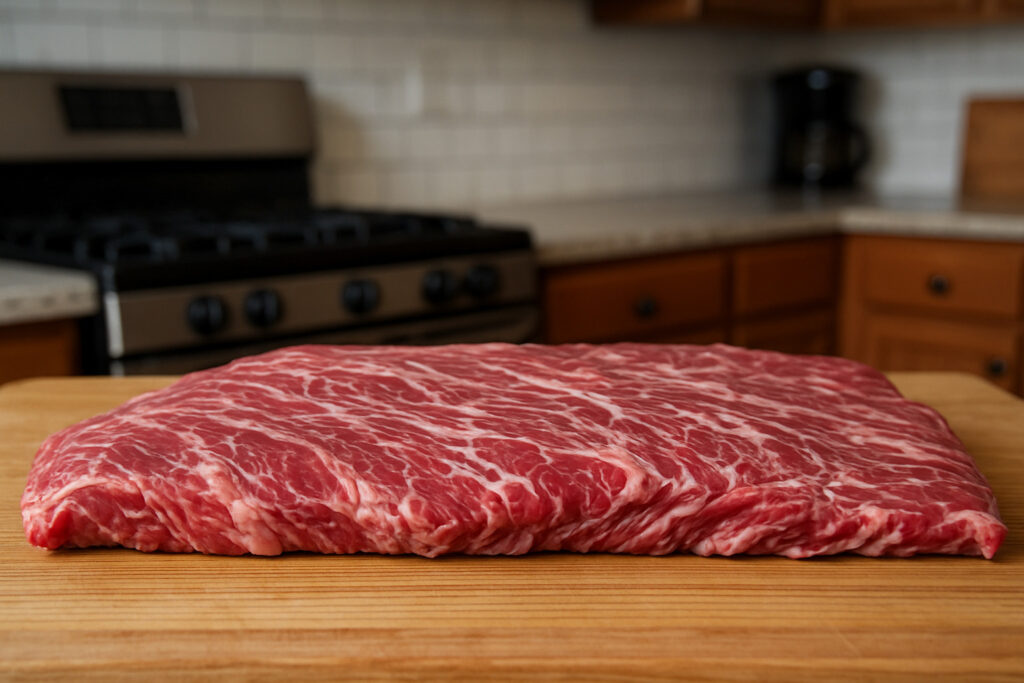Why Skirt Steak is the Ultimate Flavorful Cut
Skirt steak is a long, flat cut of beef from the cow’s plate section that packs more bold, beefy flavor per pound than almost any other steak. This thin, marbled cut comes from the diaphragm muscle and has become a favorite among chefs and home cooks who want maximum taste without the premium price tag.
Quick Skirt Steak Facts:
- Location: Plate section (diaphragm muscle, 6th-12th ribs)
- Flavor: Intense, beefy, umami-rich
- Texture: Chewy but juicy when cooked right
- Best cooking: High heat, 2-3 minutes per side
- Key technique: Always slice against the grain
- Perfect for: Fajitas, carne asada, stir-fries
What makes skirt steak special is its accordion-like grain structure that creates three times more surface area than a strip steak of the same weight. This means marinades penetrate deeper and faster, making it ideal for quick flavor infusions.
The cut gained popularity when Texas vaqueros used this affordable option for the first fajitas, turning what was once considered a lesser cut into a culinary star. Today, it’s prized in everything from Mexican arrachera to Japanese harami.
For sustainable dining enthusiasts, skirt steak represents nose-to-tail cooking at its best – using every part of the animal while delivering restaurant-quality results at home.
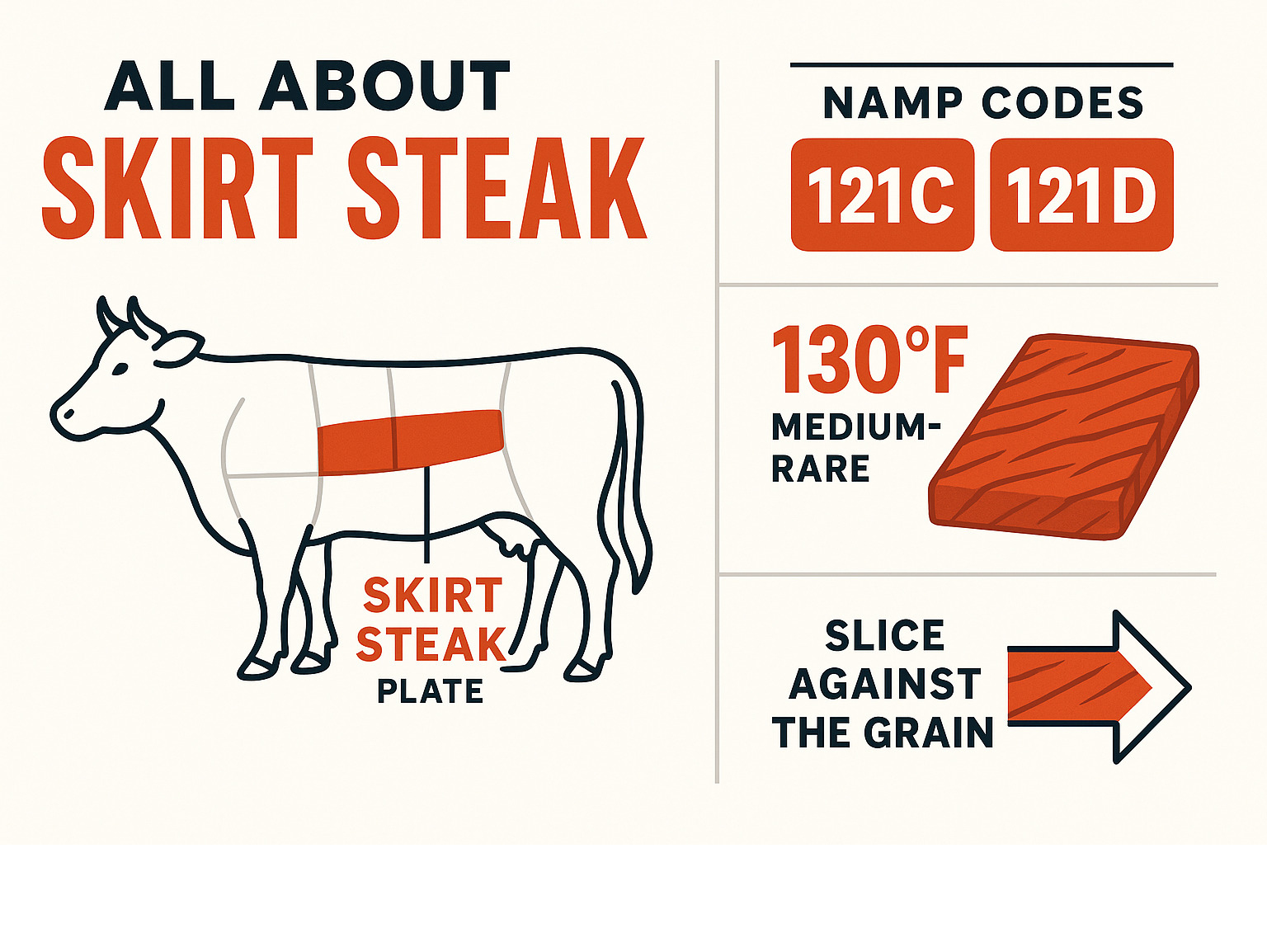
Easy skirt steak glossary:
Skirt Steak 101: Anatomy, Codes, and Flavor Profile
Here’s what makes skirt steak so special: it comes from one of the hardest-working muscles in the entire cow. This cut originates from the costal diaphragm muscle, which sits in the plate primal just below the rib section. Every time the cow breathes, this muscle flexes – and all that movement creates the intense, concentrated flavor that steak lovers crave.
The meat industry uses NAMP 121C for outside skirt and NAMP 121D for inside skirt. Think of these like part numbers that ensure you get exactly what you’re ordering.
What’s fascinating about skirt steak is its pleated grain structure that literally looks like a folded skirt. This accordion-like structure creates about three times more surface area than a strip steak of the same weight. Those peaks and valleys act like tiny flavor pockets, grabbing onto marinades and seasonings.
The flavor profile is boldly beefy with deep umami notes that make your taste buds sit up and pay attention. You’ll see beautiful marbling streaked throughout the reddish meat, which keeps it juicy during cooking. Scientific research on beef diaphragm confirms what chefs have known for years – all that muscle movement during the animal’s life develops incredibly complex flavors.
Where Skirt Steak Sits on the Cow
Skirt steak hangs underneath the cow’s ribcage like a meaty curtain, attached to ribs 6 through 12 in the short plate section. This is prime real estate for developing flavor because the diaphragm muscle never gets a break from its breathing duties.
Key Characteristics at a Glance
Skirt steak has a distinctive long, flat shape that’s unmistakable once you know what to look for. It typically measures 1/2 to 1 inch thick but can stretch anywhere from 3 to 7 inches wide. The visible marbling creates beautiful white streaks against the reddish-brown meat, and the grain runs clearly across the width.
The texture hits that perfect sweet spot of chewy yet juicy when you cook it right. The slightly coarse grain soaks up marinades like a sponge and becomes surprisingly tender when you slice it correctly against the grain.
Inside vs. Outside Skirt & Similar Cuts Compared
When you’re standing at the butcher counter, you might notice two types of skirt steak available – and yes, they’re genuinely different cuts. Outside skirt (NAMP 121C) is the more coveted option, measuring about 3-4 inches wide and maintaining a consistent 1/2 to 1-inch thickness. Inside skirt (NAMP 121D) stretches wider at 5-7 inches but runs much thinner at just 1/4 to 1/2 inch thick.
The thickness difference matters more than you might think. Outside skirt’s uniform profile means you can achieve that perfect pink center without the edges turning gray and chewy. Inside skirt, while still delicious, requires a more careful eye since its thinner profile can go from perfect to overcooked in literally seconds.
Skirt steak isn’t the only quick-cooking, flavorful cut worth knowing about. Flank steak comes from the flank primal (just behind the plate section) and offers a milder, cleaner beef flavor. Hanger steak hangs between the ribs and tenderloin, delivering intense beefiness with a different texture profile. Flap meat from the sirloin tip provides similar value but with its own unique grain structure.
| Cut | Size | Tenderness | Typical Price |
|---|---|---|---|
| Outside Skirt | 3-4″ wide, 1/2-1″ thick | Most tender | $$$ |
| Inside Skirt | 5-7″ wide, 1/4-1/2″ thick | Moderate | $$ |
| Flank Steak | 8-10″ wide, 1″ thick | Moderate | $$ |
| Hanger Steak | 6-8″ long, 1-2″ thick | Very tender | $$$ |
| Flap Meat | Varies, 1/2-1″ thick | Moderate | $ |
Inside vs. Outside: Which to Buy?
If you spot both options at your butcher, go with outside skirt every time. That extra thickness gives you a much more forgiving cooking window, and the meat tends to have less tough membrane to trim away. An average outside skirt weighs about 1.75 pounds when trimmed, perfect for feeding 3-4 people.
Inside skirt averages around 2 pounds but requires more attention during cooking. The thinner profile means it can transform from beautifully pink to gray and tough in the blink of an eye. If inside skirt is your only option, consider giving it a gentle pounding with a meat mallet to break down those muscle fibers a bit more.
The membrane situation varies between the two cuts as well. Outside skirt usually has minimal silver skin that’s easy to trim, while inside skirt often comes with more stubborn connective tissue that needs careful removal with a sharp knife.
Skirt Steak vs. Flank & Hanger
Here’s where skirt steak really shines – it packs more bold, beefy flavor than flank steak thanks to its higher fat content and unique muscle structure. Flank steak tastes clean and beefy, but skirt steak delivers that rich, almost funky intensity that makes your taste buds sit up and pay attention.
The grain direction tells the whole story about how to handle these cuts. Skirt steak has grain running across its width, making it easy to spot which way to slice. Flank steak’s grain runs lengthwise, while hanger steak presents a more complex grain pattern that requires careful observation.
Cooking times vary significantly between these cuts. Skirt steak cooks fastest at just 2-3 minutes per side over high heat. Flank steak needs 4-6 minutes per side, and hanger steak falls somewhere in the middle. All three cuts demand high-heat cooking and proper slicing against the grain, but skirt steak’s quick cooking time makes it perfect for weeknight dinners when you want maximum flavor with minimum fuss. More info about premium cuts can help you understand how these hardworking muscle cuts compare to more tender options.
Buying, Preparing, and Tenderizing Skirt Steak
Shopping for skirt steak means looking for pieces with beautiful marbling streaking through bright red meat – avoid anything that looks dry, grayish, or has excessive tough membrane clinging to the surface.
Ask specifically for outside skirt if it’s available, and don’t be shy about requesting that your butcher trim away any stubborn membrane. For portion planning, figure about 8-10 ounces per person when skirt steak is the star of your meal.
Preparation starts with a good trim. Any silver skin or tough membrane on the surface needs to go because it won’t break down during cooking. If you’re working with inside skirt or want extra tenderness, light pounding with a meat mallet helps break up those muscle fibers.
Dry brining is a game-changer for skirt steak. Salt the meat about 40 minutes before cooking, and you’ll see moisture draw out initially, then get reabsorbed along with the salt. This process tenderizes while enhancing the natural beef flavor.
Marinating Skirt Steak for Maximum Flavor
The pleated grain structure of skirt steak makes it a marinating superstar. Those accordion-like folds create channels that pull flavors deep into the meat faster than almost any other cut. You can achieve meaningful flavor penetration in just 30 minutes, though longer marinades up to 24 hours will give you even more complex results.
Citrus-soy combinations work beautifully with this cut. Try mixing soy sauce with fresh lime juice, minced garlic, and a touch of brown sugar for balance. For authentic Mexican flavors, beer-based carne asada marinades are hard to beat. The natural enzymes in beer help break down proteins while adding subtle malt sweetness.
Sometimes simpler is better. Oil-herb rubs applied just before cooking let the pure beef flavor shine through. A mixture of olive oil, crushed garlic, fresh herbs, salt, and cracked pepper improves without masking the meat’s natural character.
Scientific research on marinades and flavor penetration shows that acidic marinades work best for 30 minutes to 4 hours, while enzymatic marinades containing pineapple, papaya, or beer should be limited to prevent the meat from becoming mushy.
Common Mistakes to Avoid
The biggest heartbreak with skirt steak is overcooking it. This thin cut transforms from perfectly juicy medium-rare to tough shoe leather in less than a minute. Always use an instant-read thermometer and pull the meat at 130°F.
Skipping the rest period means missing out on the best part. Your skirt steak needs 5-10 minutes under loose foil to let those precious juices redistribute throughout the meat.
The wet surface mistake prevents that gorgeous sear you’re after. Even if you’ve marinated your steak, pat it completely dry with paper towels before it hits the heat. Finally, there’s the grain direction trap – slicing with the grain instead of against it turns even perfectly cooked skirt steak into a chewy disappointment.
Cooking Skirt Steak: Grill, Pan, Sous Vide & More
The secret to perfect skirt steak lies in understanding that this thin, flavorful cut loves aggressive heat. Think of it as the opposite of a thick ribeye – instead of gentle, slow cooking, skirt steak wants to be seared fast and hard to develop that beautiful crust while keeping the interior juicy and tender.
Your best friends for cooking skirt steak are high-heat methods that can quickly caramelize the surface. A raging hot charcoal grill hitting 700°F is absolutely perfect, though a gas grill at 500-550°F works beautifully too. On the stovetop, a cast-iron skillet becomes your secret weapon – it holds heat like nobody’s business and gives you restaurant-quality results.
Don’t overlook your broiler either. Position the rack 4-6 inches from the heating element and you’ve got an indoor grill that can rival any backyard setup. Just keep a close eye on things since skirt steak cooks lightning-fast under that intense heat.
For the precision-minded home cook, sous vide at 129°F for 2-4 hours guarantees edge-to-edge perfection, then finish with a scorching hot sear for that essential crust. The reverse sear method works wonderfully for thicker outside skirt – start low in a 275°F oven until the internal temperature hits 120°F, then blast it with high heat.
Here’s the crucial part: carryover heat is real with skirt steak. That thin profile means the internal temperature can climb 5-10°F while resting, so pull it off the heat at 125-130°F for perfect medium-rare results. An instant-read thermometer takes all the guesswork out of the equation.
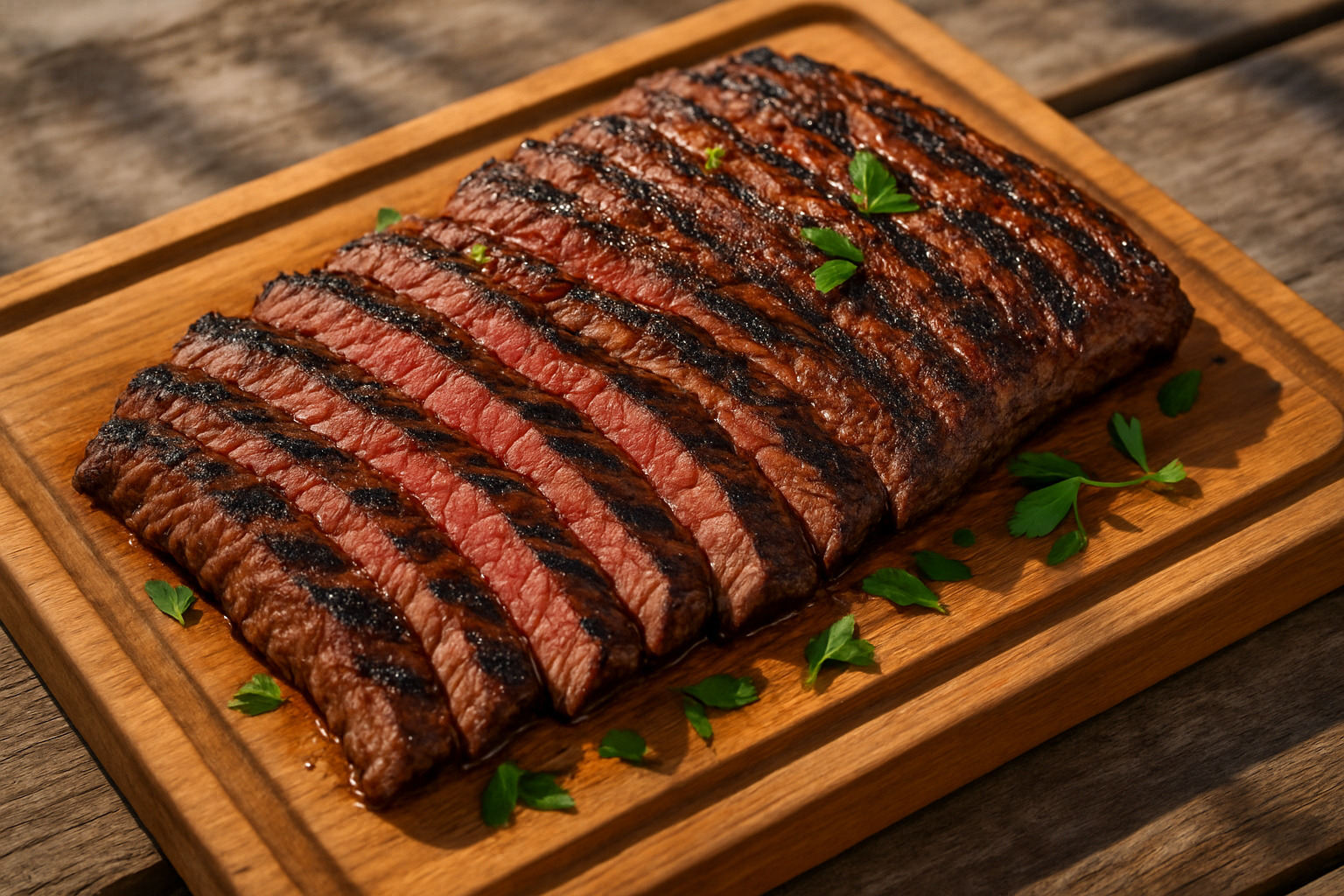
Grilling Skirt Steak Medium-Rare
Getting your grill screaming hot is step one for perfect skirt steak. We’re talking 700°F grate temperature if your grill can handle it. Clean those grates thoroughly and give them a light oil coating to prevent sticking – nobody wants to leave half their steak behind on the grill.
Pat your skirt steak bone dry with paper towels, even if you’ve marinated it. Any surface moisture will create steam instead of that gorgeous sear we’re after. Season it right before it hits the grill to prevent drawing out precious juices.
Place the steak directly over your hottest zone and resist every urge to peek, poke, or move it around. Let it do its thing for 2-3 minutes until you see serious charring developing. The smell alone will tell you when it’s ready to flip.
One flip, then another 2-3 minutes for medium-rare perfection. Total cooking time should be 4-6 minutes depending on thickness. That smoky char combined with the juicy, beefy interior creates pure magic that’s absolutely perfect for fajitas or slicing over a fresh salad.
Remove it from the grill and tent loosely with foil. Let it rest for 5 minutes – this isn’t optional, it’s essential for keeping all those flavorful juices where they belong.
Pan-Searing in Cast Iron
Cast iron pan-searing gives you complete control over your skirt steak trip. Heat that skillet over high heat for 3-4 minutes until it’s properly smoking. The beauty of cast iron is its thermal mass – it stays hot even when you add cold meat to the pan.
Choose your oil wisely here. Avocado oil or grapeseed oil won’t break down under the intense heat like olive oil might. You want just enough to coat the pan – too much creates a greasy mess and uneven browning.
Make sure your skirt steak is completely dry and season it just before it hits the pan. When it touches that hot surface, it should sound like a angry snake – that aggressive sizzling means you’re doing it right. Two minutes without moving it, then flip and give it another two minutes.
Here’s a pro tip: add a knob of butter, some smashed garlic, and fresh thyme during the last minute and baste that steak like you mean it. The aromatics will infuse the meat while the butter adds richness. Just make sure your stovetop ventilation is cranked up – this high-heat cooking creates plenty of smoke, but it’s the good kind.
Slicing Skirt Steak Against the Grain
This is where good skirt steak becomes great skirt steak. Proper slicing technique literally transforms the texture from potentially chewy to fork-tender perfection. The secret is reading the meat’s natural grain pattern – those lines of muscle fibers running across the surface.
Your knife needs to cut perpendicular to those lines at a 45-degree bias angle. This bias cut exposes maximum surface area and shortens those muscle fibers to their most tender length possible. Aim for 1/4-inch thick slices – go thicker and you’ll definitely notice the chewiness.
The visual cues are your best guide here. Look for the natural striations in the meat and notice how it wants to separate when you start cutting. If your first slice seems tough, you’re probably cutting with the grain instead of against it – just rotate your cutting angle 90 degrees.
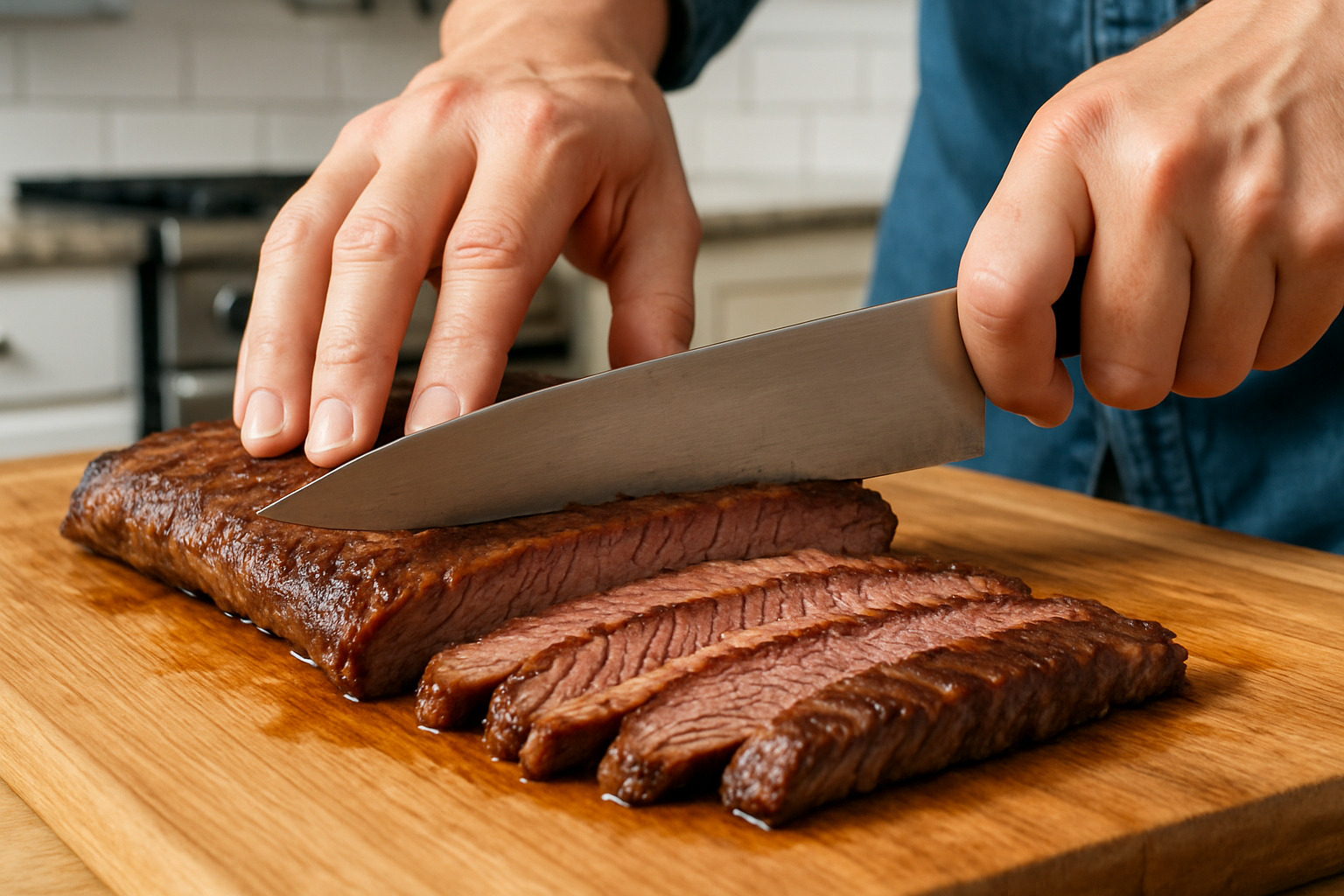
Use the sharpest knife you have for clean cuts that don’t tear the meat fibers. A dull knife will mash and bruise the meat, releasing those precious juices onto your cutting board instead of keeping them where they belong – in every delicious bite.
Serving, Nutrition, Storage, and Pairings
Skirt steak transforms into culinary magic when paired with the right flavors and preparations. This cut practically begs for bold, vibrant accompaniments that can match its intense beefiness.
Nothing beats classic fajitas with sizzling peppers and onions – the steak’s robust flavor holds up beautifully to caramelized vegetables and warm tortillas. Mexican arrachera tacos showcase the meat’s natural character with just lime, cilantro, and diced onions. Asian stir-fries are another natural fit, while Philly cheesesteaks benefit from skirt steak’s chewy texture.
Chimichurri sauce might be the perfect partner for skirt steak – the bright herbs and tangy vinegar cut right through the rich beef flavors. Other winning combinations include salsa verde, Korean gochujang glaze, or simple compound butter with fresh herbs.

From a nutrition standpoint, skirt steak delivers impressive protein density. A 4-ounce serving packs about 330 calories and 24 grams of protein, along with 23 grams of fat. You’re also getting solid amounts of iron, zinc, and B vitamins.
Wine lovers should reach for bold reds that won’t be overwhelmed. Malbec, Zinfandel, or Tempranillo all complement the meat’s intensity beautifully. Beer works just as well – crisp Mexican lagers are perfect with carne asada, while hoppy IPAs have enough character to stand up to the beef’s richness.
For storage, keep fresh skirt steak in the refrigerator for up to 3 days or freeze for up to 3 months. Vacuum sealing before freezing prevents freezer burn and maintains quality longer.
Portion Guide & Meal Planning
Planning portions for skirt steak is straightforward – figure on 8-10 ounces of raw meat per person for main course servings. When cooking for a crowd, skirt steak is both economical and practical. A 3-pound piece easily feeds 6-8 people.
Leftover skirt steak is fantastic cold in salads or grain bowls, and reheats beautifully for breakfast alongside scrambled eggs. The intense flavor actually holds up well to storage, making it perfect for meal prep strategies. More info about ground beef ideas can help you explore other budget-friendly beef options for weekly meal planning.
Reheating Without Drying Out
The biggest challenge with leftover skirt steak is reheating it without turning it into shoe leather. The steam-sauté method works like magic – heat a pan with a tiny bit of oil or butter, add your sliced steak, and toss quickly just until warmed through. We’re talking 30-60 seconds max.
If you have a sous vide setup, reheating at 120°F for 30 minutes brings leftover skirt steak back to serving temperature without any additional cooking.
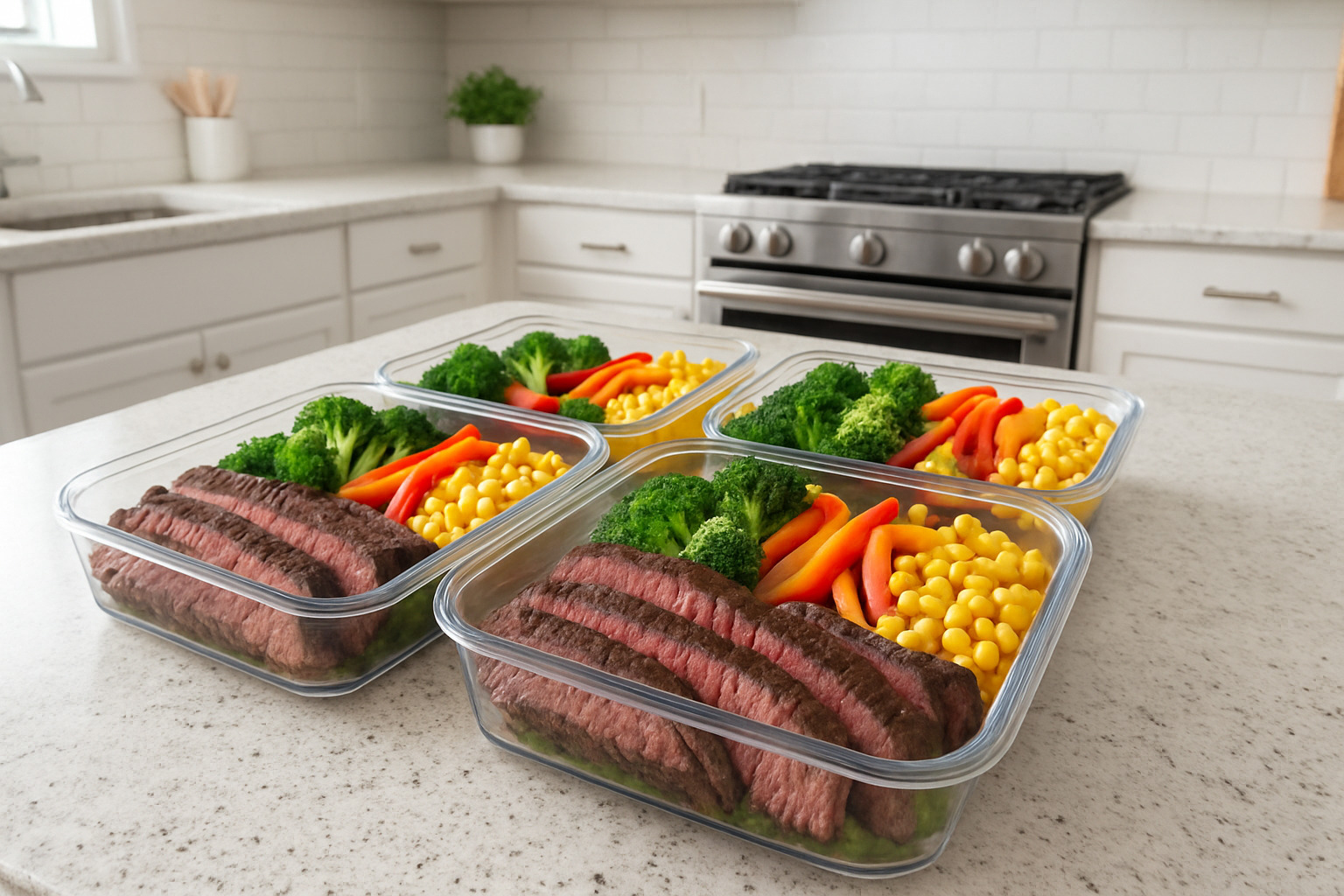
Frequently Asked Questions about Skirt Steak
Why is my skirt steak tough?
Nothing’s more disappointing than biting into tough skirt steak when you’re expecting that perfect chewy-yet-tender texture. The most common culprit is overcooking – this thin cut transforms from juicy to jerky-like in just minutes.
Skirt steak should never go beyond medium doneness. Aim for 130°F internal temperature, and remember that carryover heat will bring it up another 5 degrees during resting.
Your slicing technique makes an enormous difference too. If you’re cutting with the grain instead of against it, you’re leaving those long muscle fibers intact, making every bite a workout for your jaw. Look for those parallel lines running across the meat and cut perpendicular to them.
Don’t skip the resting period either. Those 5-10 minutes under foil allow the muscle fibers to relax and the juices to redistribute throughout the meat.
Do I really have to slice against the grain?
Absolutely, and here’s why it makes such a dramatic difference with skirt steak. This cut comes from the diaphragm muscle, which has particularly long, tough fibers. When you slice against the grain, you’re essentially cutting those long fibers into tiny, manageable pieces.
The 45-degree bias cut we recommend isn’t just fancy knife work – it exposes maximum surface area and creates the most tender bite possible. You’ll literally taste the difference between properly sliced and improperly sliced meat from the exact same steak.
How long can I marinate skirt steak safely?
Skirt steak is incredibly receptive to marinades thanks to its high surface area, but timing matters. You can safely marinate for up to 24 hours in the refrigerator, but the sweet spot depends on what’s in your marinade.
Acidic marinades with citrus juice, vinegar, or wine work their magic quickly. Between 30 minutes and 4 hours is usually perfect. Enzymatic marinades containing pineapple, papaya, or beer are more aggressive, so limit them to 2-4 hours maximum. Oil-based marinades with herbs, garlic, and spices are the gentlest option and can go the full 24 hours.
Conclusion
Skirt steak represents everything we love about bold, flavorful cooking here at The Dining Destination. This remarkable cut proves that you don’t need to spend a fortune to create memorable meals that rival the best restaurants in New York City or anywhere else in the world.
What makes skirt steak so special is how it rewards proper technique with incredible flavor. Master the high-heat sear, learn to slice against the grain, and understand the importance of timing – these skills will transform not just your steak game, but your entire approach to cooking.
The sustainability aspect can’t be overlooked either. When you choose skirt steak, you’re embracing nose-to-tail cooking that honors the whole animal. It’s a delicious way to make more conscious dining choices without sacrificing satisfaction or flavor.
From sizzling fajitas that fill your kitchen with amazing aromas to neat chimichurri-topped slices that impress dinner guests, skirt steak adapts to any occasion. The techniques you’ve learned – the quick marinades, the perfect searing, the precise slicing – will serve you well in countless other culinary trips.
Ready to explore more ways to bring restaurant-quality experiences to your table? Our guide to farm-to-table dining experiences shows how ingredients like premium skirt steak make their journey from pasture to plate, connecting you with the full story of your food.
Whether you’re planning a casual weeknight dinner or hosting a special gathering, skirt steak delivers every time. The bold flavors, the satisfying texture, and the pure joy of getting it just right – that’s what great cooking is all about.

